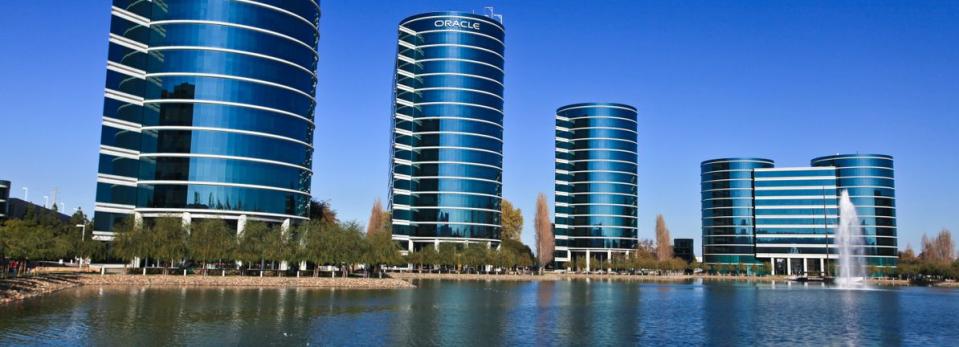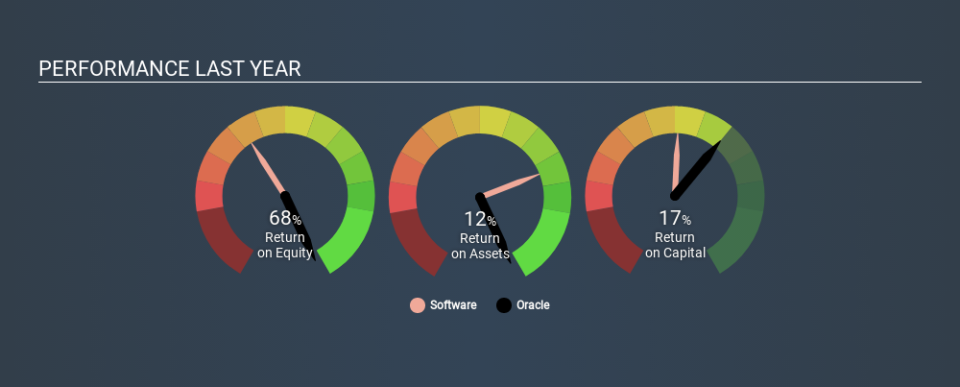Is Oracle Corporation’s (NYSE:ORCL) 17% ROCE Any Good?

Today we'll evaluate Oracle Corporation (NYSE:ORCL) to determine whether it could have potential as an investment idea. Specifically, we're going to calculate its Return On Capital Employed (ROCE), in the hopes of getting some insight into the business.
First, we'll go over how we calculate ROCE. Then we'll compare its ROCE to similar companies. Then we'll determine how its current liabilities are affecting its ROCE.
Understanding Return On Capital Employed (ROCE)
ROCE measures the amount of pre-tax profits a company can generate from the capital employed in its business. In general, businesses with a higher ROCE are usually better quality. Ultimately, it is a useful but imperfect metric. Author Edwin Whiting says to be careful when comparing the ROCE of different businesses, since 'No two businesses are exactly alike.
So, How Do We Calculate ROCE?
Analysts use this formula to calculate return on capital employed:
Return on Capital Employed = Earnings Before Interest and Tax (EBIT) ÷ (Total Assets - Current Liabilities)
Or for Oracle:
0.17 = US$14b ÷ (US$98b - US$15b) (Based on the trailing twelve months to November 2019.)
Therefore, Oracle has an ROCE of 17%.
Check out our latest analysis for Oracle
Is Oracle's ROCE Good?
ROCE is commonly used for comparing the performance of similar businesses. Using our data, we find that Oracle's ROCE is meaningfully better than the 9.8% average in the Software industry. We consider this a positive sign, because it suggests it uses capital more efficiently than similar companies. Regardless of where Oracle sits next to its industry, its ROCE in absolute terms appears satisfactory, and this company could be worth a closer look.
Our data shows that Oracle currently has an ROCE of 17%, compared to its ROCE of 12% 3 years ago. This makes us wonder if the company is improving. You can see in the image below how Oracle's ROCE compares to its industry. Click to see more on past growth.
When considering ROCE, bear in mind that it reflects the past and does not necessarily predict the future. Companies in cyclical industries can be difficult to understand using ROCE, as returns typically look high during boom times, and low during busts. ROCE is, after all, simply a snap shot of a single year. What happens in the future is pretty important for investors, so we have prepared a free report on analyst forecasts for Oracle.
What Are Current Liabilities, And How Do They Affect Oracle's ROCE?
Short term (or current) liabilities, are things like supplier invoices, overdrafts, or tax bills that need to be paid within 12 months. The ROCE equation subtracts current liabilities from capital employed, so a company with a lot of current liabilities appears to have less capital employed, and a higher ROCE than otherwise. To counteract this, we check if a company has high current liabilities, relative to its total assets.
Oracle has total assets of US$98b and current liabilities of US$15b. As a result, its current liabilities are equal to approximately 15% of its total assets. A fairly low level of current liabilities is not influencing the ROCE too much.
The Bottom Line On Oracle's ROCE
With that in mind, Oracle's ROCE appears pretty good. Oracle shapes up well under this analysis, but it is far from the only business delivering excellent numbers . You might also want to check this free collection of companies delivering excellent earnings growth.
If you are like me, then you will not want to miss this free list of growing companies that insiders are buying.
If you spot an error that warrants correction, please contact the editor at editorial-team@simplywallst.com. This article by Simply Wall St is general in nature. It does not constitute a recommendation to buy or sell any stock, and does not take account of your objectives, or your financial situation. Simply Wall St has no position in the stocks mentioned.
We aim to bring you long-term focused research analysis driven by fundamental data. Note that our analysis may not factor in the latest price-sensitive company announcements or qualitative material. Thank you for reading.

 Yahoo Finance
Yahoo Finance 
